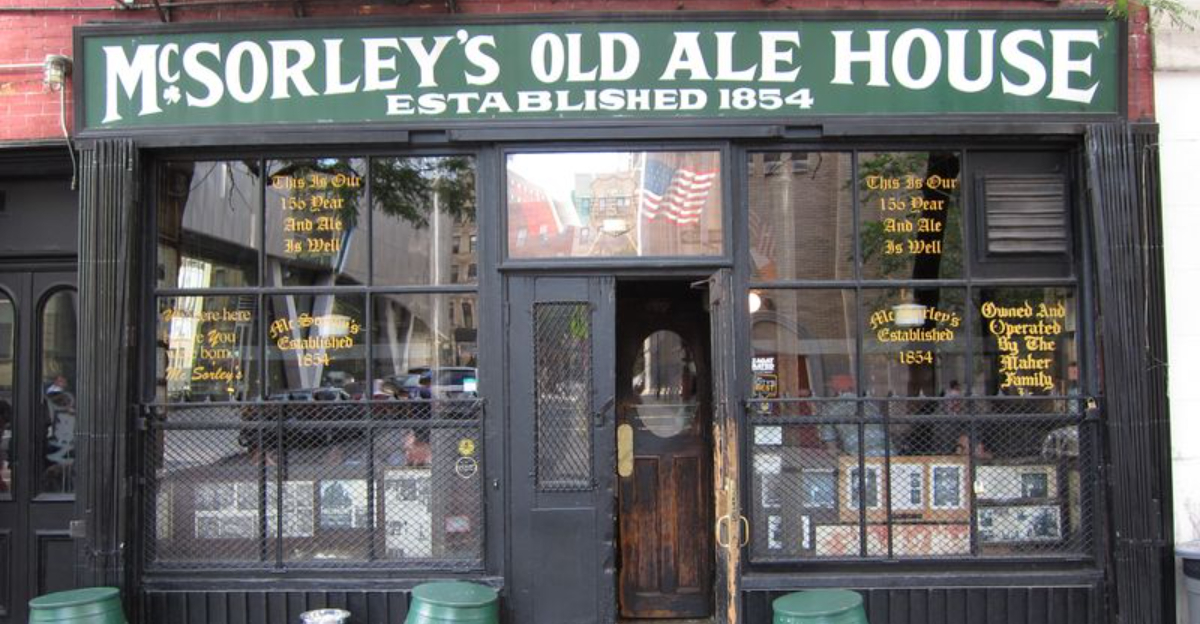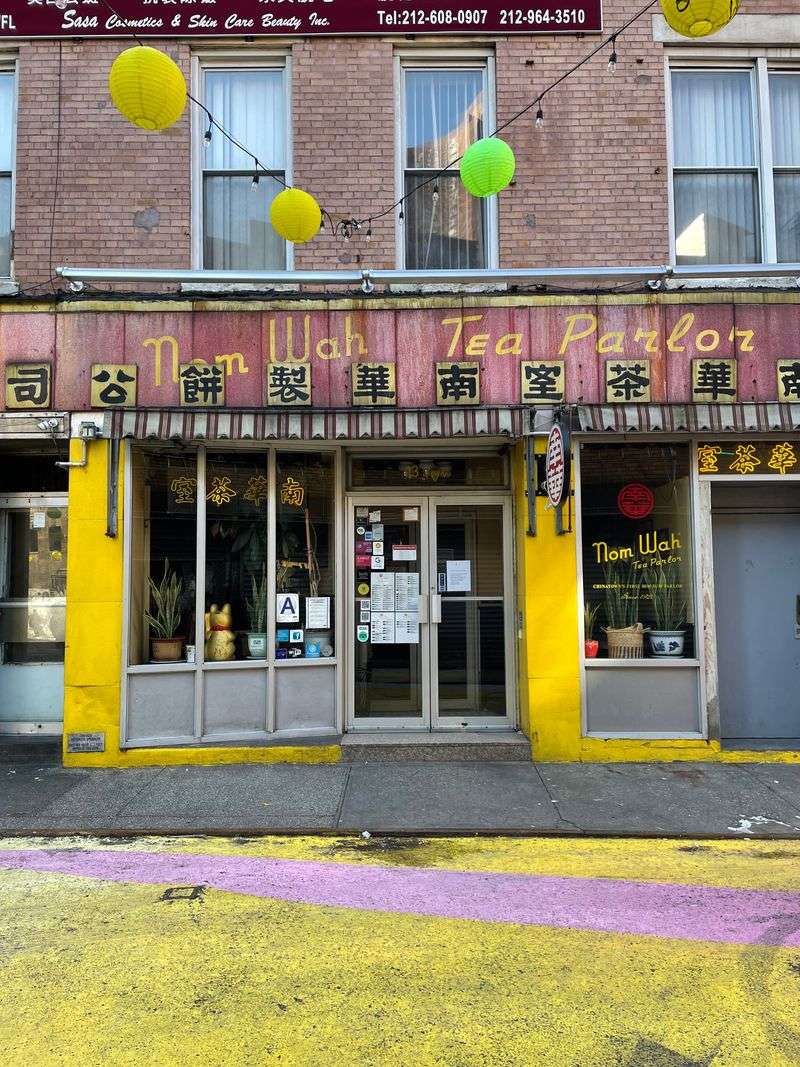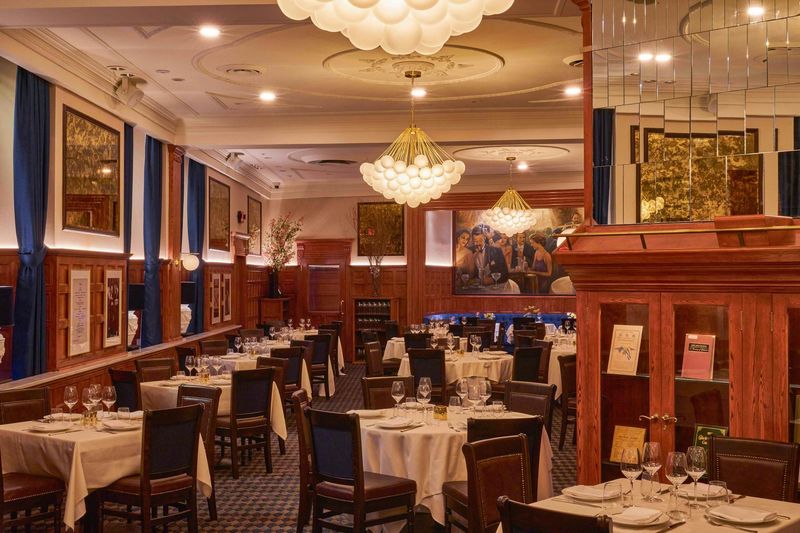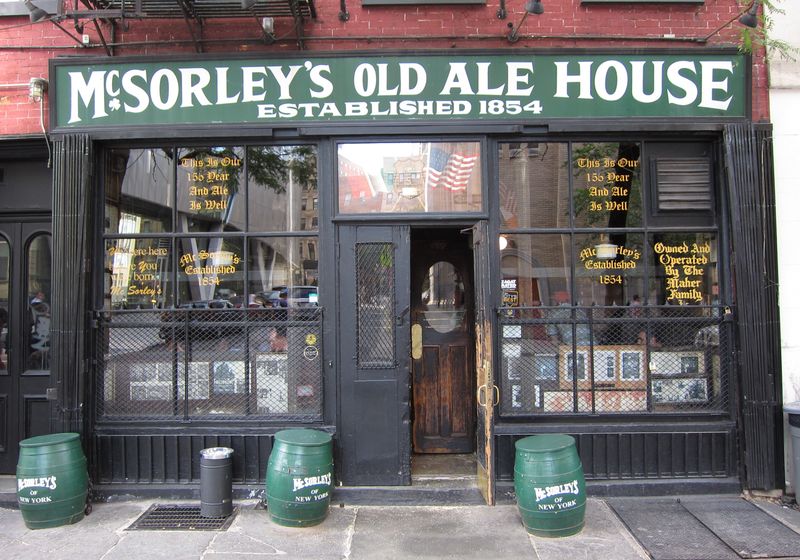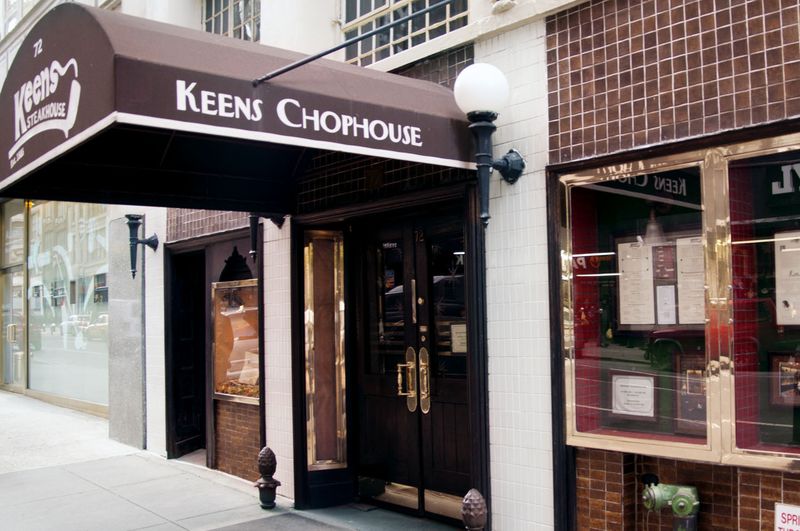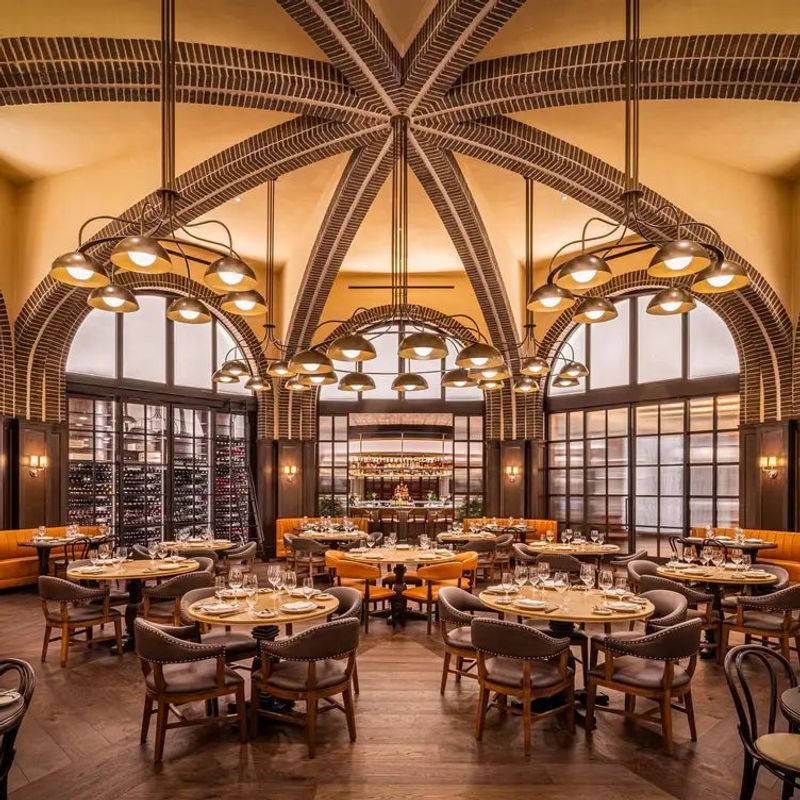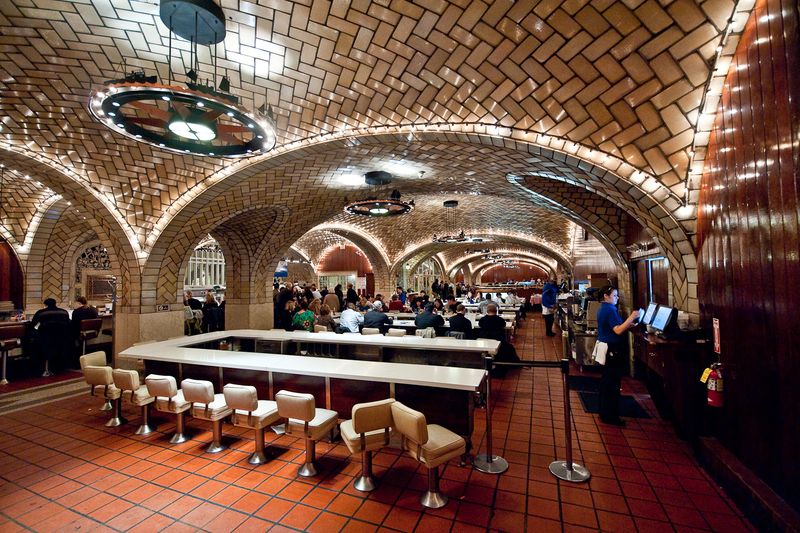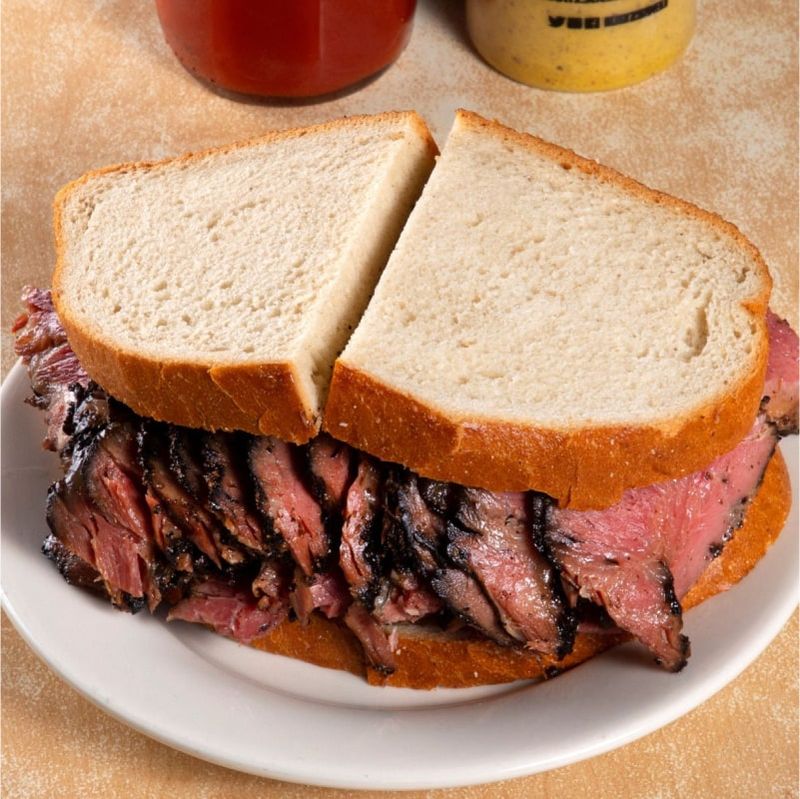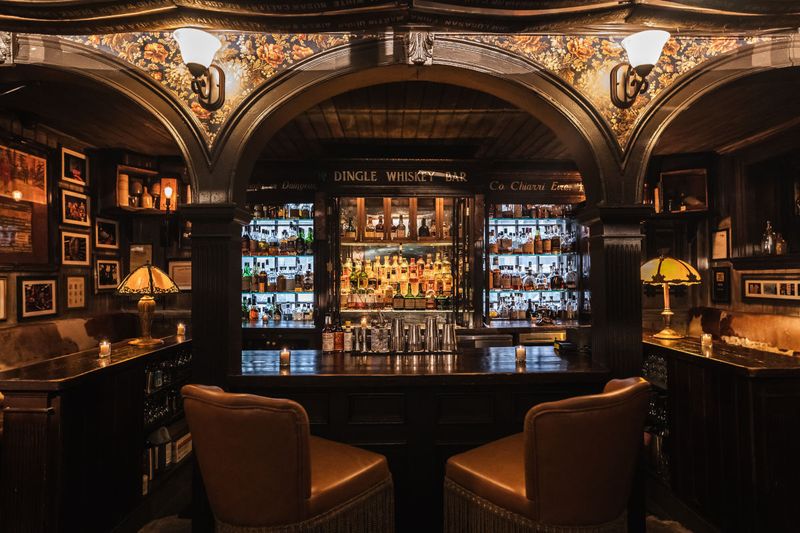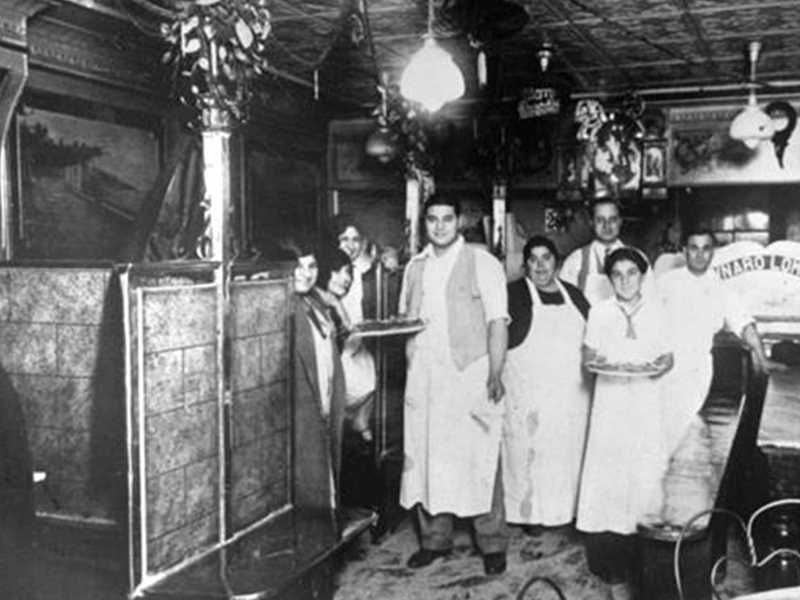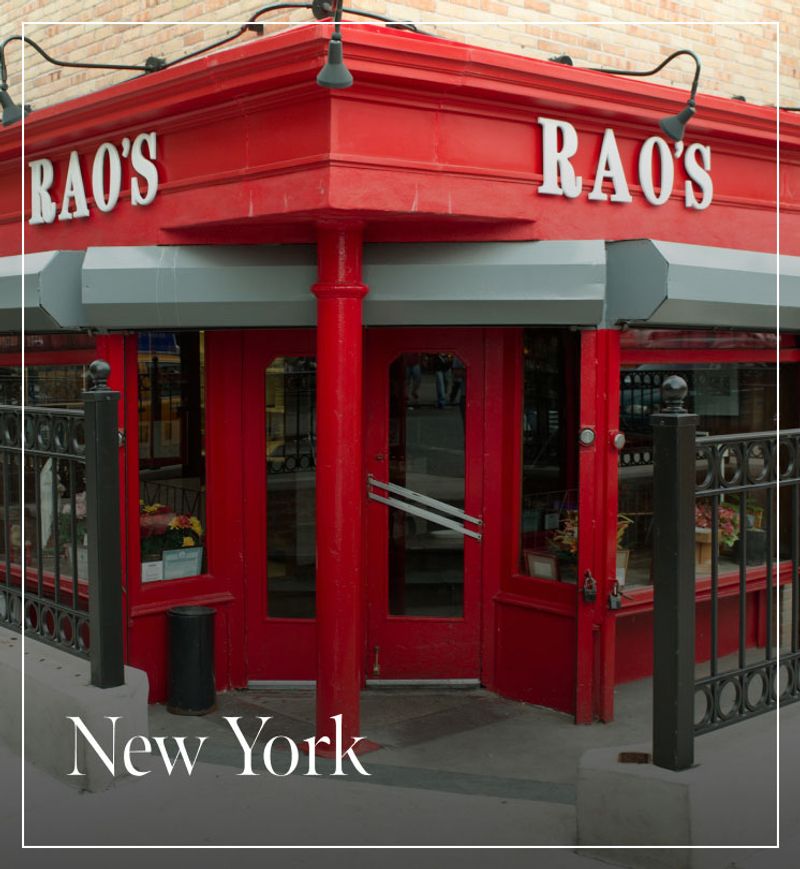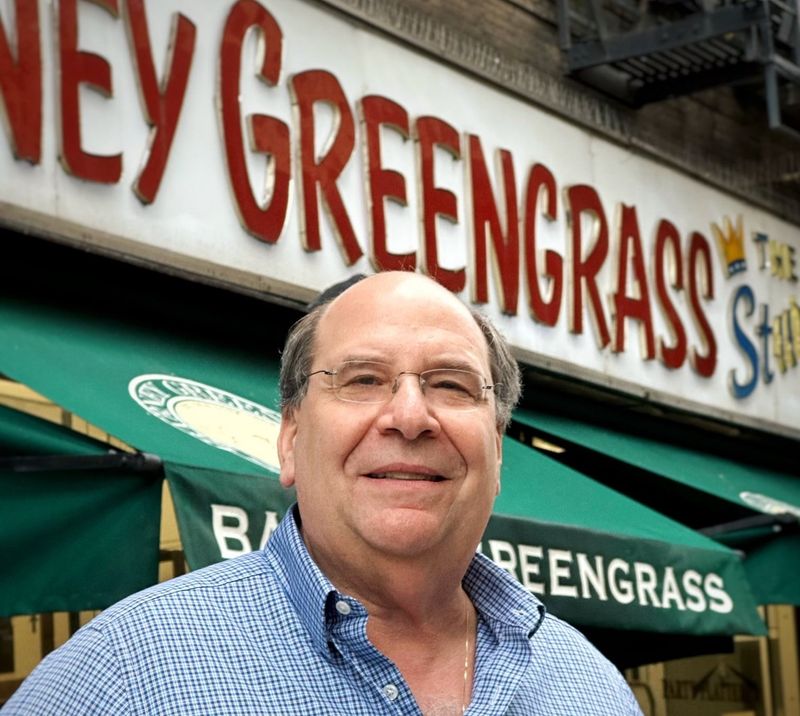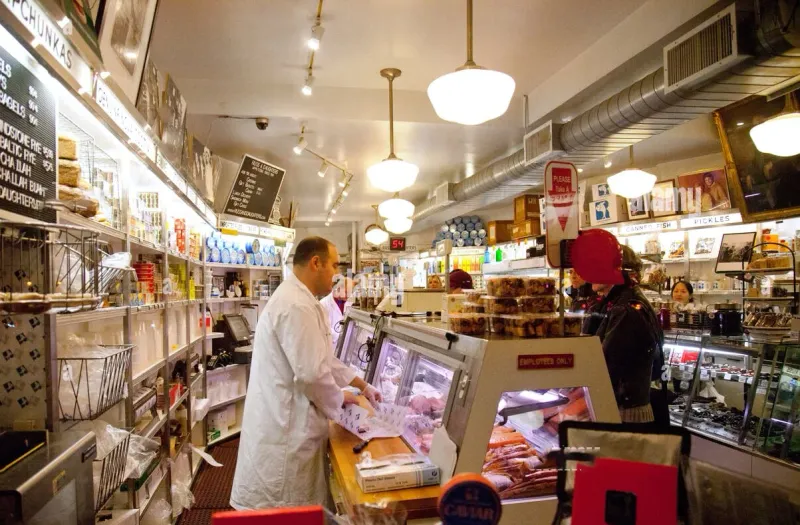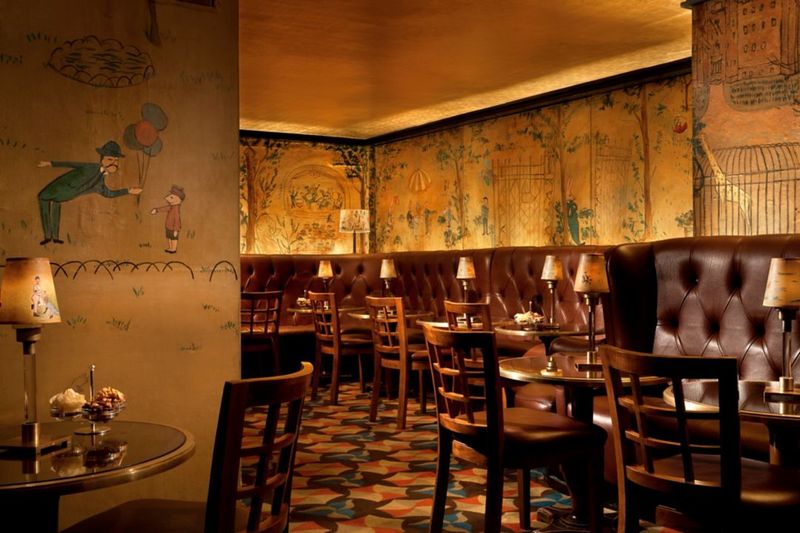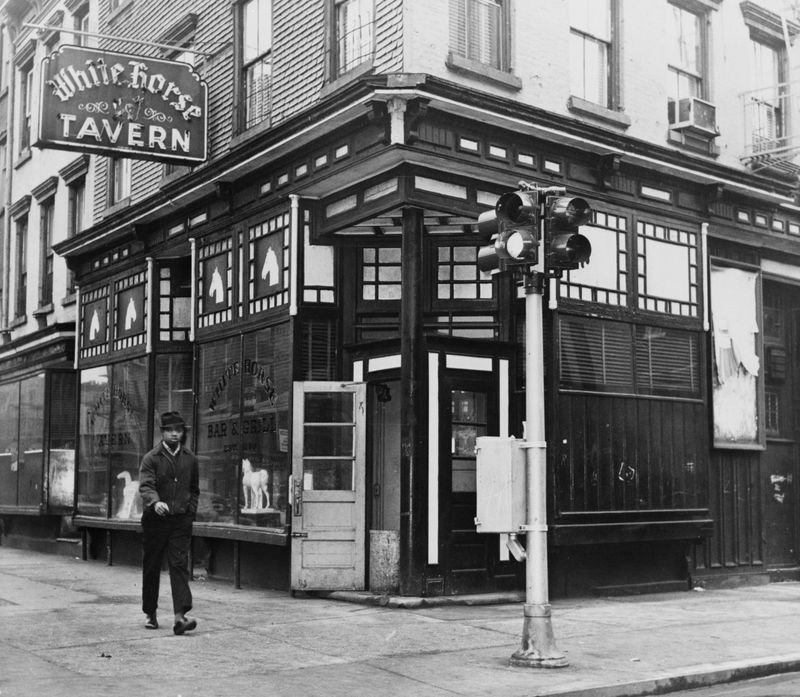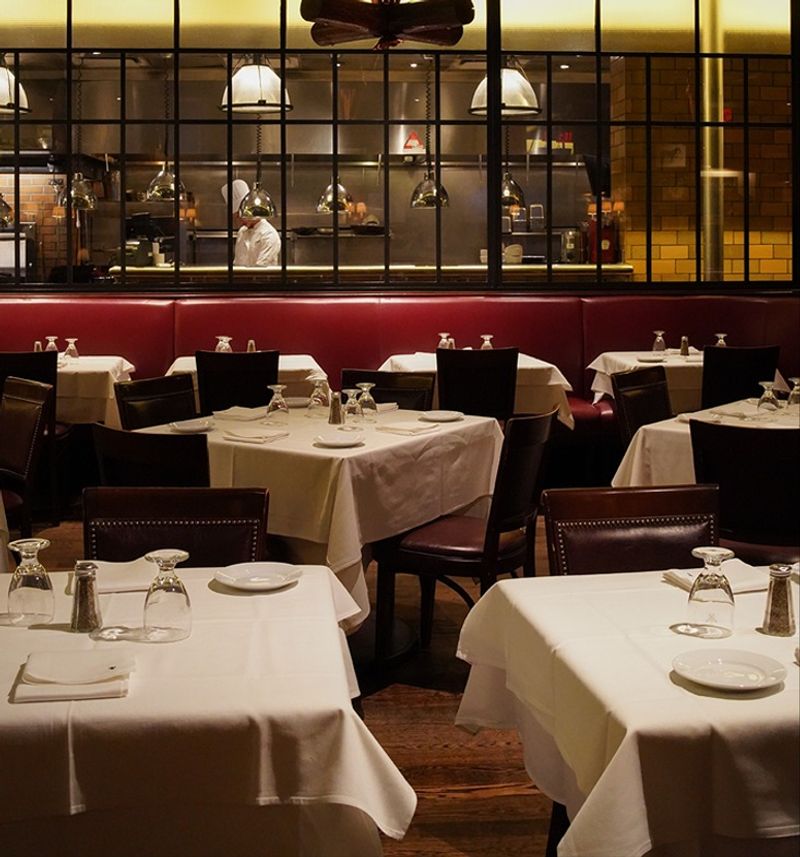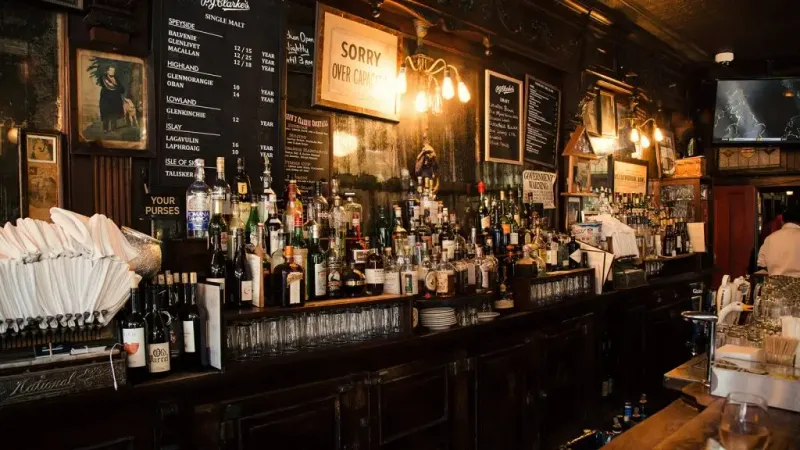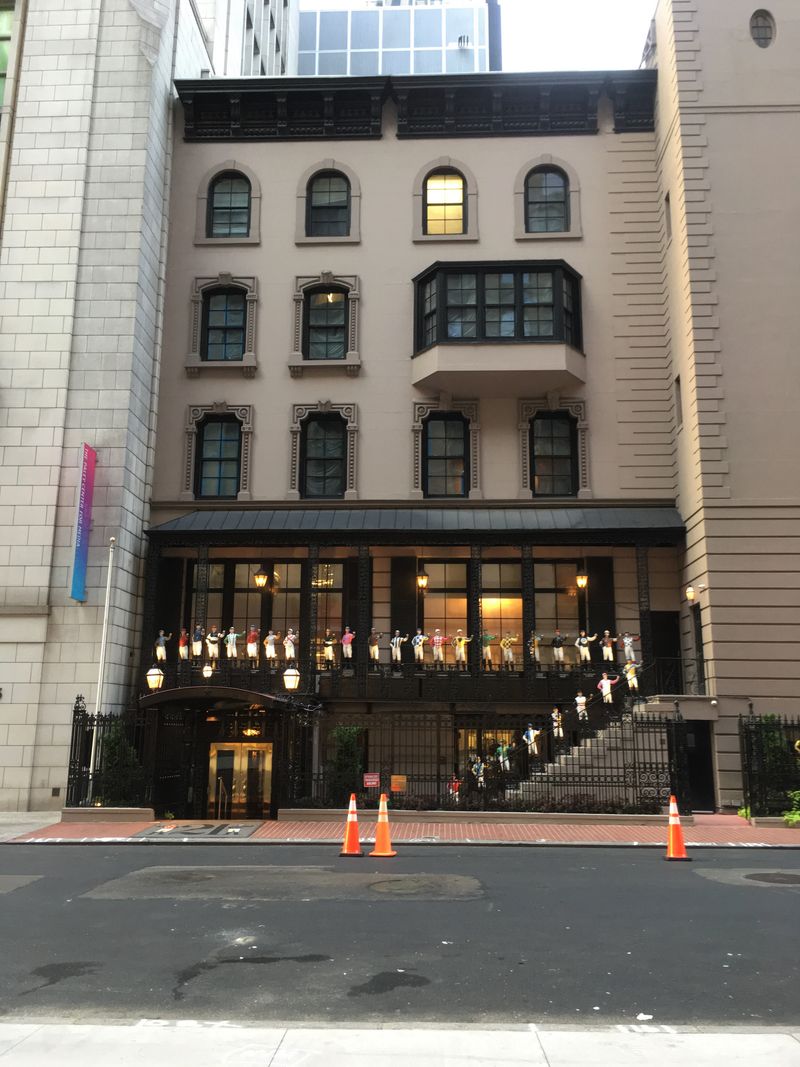New York City’s restaurant scene isn’t just about cutting-edge cuisine—it’s also home to historic eateries that have witnessed generations of diners and decades of city history. These legendary establishments have survived wars, economic downturns, changing neighborhoods, and now serve up history alongside their signature dishes. From century-old dim sum parlors to steakhouses where presidents once dined, these culinary landmarks offer a taste of old New York with every bite.
1. Nom Wah Tea Parlor: Chinatown’s Dim Sum Pioneer
Walking into Nom Wah feels like stepping back to 1920s Chinatown. Red vinyl booths and vintage decor frame this Doyers Street institution where generations of New Yorkers have gathered over steaming bamboo baskets. Famous for their rice rolls and roast pork buns, Nom Wah survived Prohibition, the Great Depression, and nearly a century of neighborhood changes. The restaurant gained renewed popularity when the founding family’s nephew took over in 2010, preserving traditional recipes while updating operations. Unlike modern dim sum restaurants with rolling carts, here you mark your selections on a paper menu—a charming throwback to simpler times.
2. Delmonico’s: America’s First Fine Dining Experience
Established in 1837, Delmonico’s revolutionized American dining by introducing the concept of a printed menu and separate tables. This Wall Street area landmark claims to have created culinary classics like Eggs Benedict, Baked Alaska, and the Delmonico steak. Mark Twain celebrated book releases here. Presidents Grant, Cleveland, and Roosevelt held important meetings over meals. The ornate interior features dark wood paneling and crisp white tablecloths that transport diners to an era of Gilded Age opulence. Though temporarily closed for renovations, this culinary institution promises to return, continuing its legacy as America’s original fine dining destination.
3. McSorley’s Old Ale House: Where Time Stands Still
Sawdust covers the floor and wishbones hung by WWI soldiers who never returned still dangle from the light fixtures. McSorley’s, operating since 1854, is a living museum where the motto remains: “Be Good or Be Gone.” The East Village institution serves just two beers—light or dark ale—brought to your table in pairs of small mugs. Women weren’t allowed inside until 1970, after a Supreme Court ruling forced them to open their doors to all. The walls showcase dusty memorabilia accumulated over 160+ years, including Houdini’s handcuffs and artwork from the bar’s early days. Abraham Lincoln and John Lennon both drank here—though not together, of course.
4. Keens Steakhouse: Home of Legendary Mutton Chops
Look up at Keens and you’ll see thousands of clay pipes hanging from the ceiling—a collection started in 1885 when pipe smoking was the gentlemen’s post-dinner ritual. Notable members of the “pipe club” included Theodore Roosevelt, Albert Einstein, and Babe Ruth. Located in the former Herald Square Theater District, actors would store their personal pipes here between performances. While the theater district moved uptown, Keens remained, serving its famous mutton chop—actually a saddle of lamb that weighs nearly two pounds. The restaurant’s dark wood-paneled rooms house one of America’s largest collections of Scotch whisky and countless historic artifacts, including an original playbill from the night Lincoln was assassinated.
5. Peter Luger: Brooklyn’s Beef Institution
Cash only, no-frills, and absolutely no compromises—that’s been Peter Luger’s approach since 1887. The Williamsburg steakhouse has a single-minded focus: serving perfectly aged USDA Prime beef selected by family members who still personally inspect each cut. German immigrant Peter Luger opened as a billiards hall with a restaurant, but the steaks quickly became the main attraction. After Luger’s death in 1941, longtime customer Sol Forman bought the place at auction and preserved its traditions. The restaurant earned Brooklyn’s first Michelin star, yet remains stubbornly old-school with waiters in bow ties, simple wooden tables, and a famous gruff service style that’s become part of the experience.
6. Grand Central Oyster Bar: Beneath the Terminal’s Vaulted Ceilings
The magnificent Guastavino-tiled vaulted ceilings alone make Grand Central Oyster Bar worth visiting. Opening alongside Grand Central Terminal in 1913, this seafood institution has served commuters and visitors beneath the transit hub for over a century. After nearly going bankrupt in the 1970s (mirroring the terminal’s own decline), chef Jerome Brody revitalized the restaurant with an expanded menu featuring up to 30 different varieties of oysters daily. The horseshoe-shaped counters offer prime spots to watch shuckers work their magic with lightning speed. The restaurant’s famous oyster stew and pan roasts are still prepared using the original steam-jacketed kettles from 1913—equipment that contributes to their distinctive flavor.
7. Katz’s Delicatessen: Where Harry Met Sally
“Send a salami to your boy in the army” was Katz’s WWII slogan, and they’ve been slicing pastrami since 1888. The Lower East Side institution gained Hollywood fame through the famous fake orgasm scene in “When Harry Met Sally,” but locals have always known its true star is the hand-carved pastrami. Each sandwich contains about a pound of meat, cured for up to 30 days and smoked for up to 3 days. The ordering system remains charmingly old-school—you’ll receive a paper ticket upon entering, which gets marked with your orders. During WWII, the “Send a Salami” campaign supported troops overseas. Today, a sign above “that table” reminds visitors where Meg Ryan filmed her memorable scene.
8. Fraunces Tavern: Where Washington Bid Farewell
George Washington gathered his officers here on December 4, 1783, to bid them farewell after the Revolutionary War. Established in 1762, Fraunces Tavern in the Financial District stands as New York’s oldest surviving building used as a tavern. The yellow brick Colonial structure houses both a working restaurant and a museum dedicated to Revolutionary War history. Samuel Fraunces, a West Indian innkeeper known as “Black Sam,” created a gathering place that witnessed pivotal moments in early American history. Today, patrons can sip porter or ale in the same rooms where the Sons of Liberty plotted resistance and early government departments operated before the capital moved to Philadelphia. The Porterhouse Bar serves over 130 craft beers and 300+ whiskeys.
9. Lombardi’s: America’s First Pizzeria
The aroma of coal-fired pizza has wafted from Lombardi’s since 1905, when Italian immigrant Gennaro Lombardi obtained the first pizzeria license in America. The original Spring Street location closed in 1984 but reopened a block away in 1994, continuing to use the same recipes and cooking techniques. Coal ovens reaching 800+ degrees create the signature slightly charred, thin crust that made New York pizza famous. The classic Margherita remains the star—topped with San Marzano tomato sauce, fresh mozzarella, and basil. Before Lombardi’s, pizza was made at home or sold by unlicensed vendors on the street. This Little Italy landmark transformed pizza from Italian street food into an American institution, training future pizza legends who would open Totonno’s and John’s.
10. Rao’s: The Restaurant You Can’t Get Into
With just ten tables and no phone number listed, Rao’s in East Harlem might be NYC’s most exclusive restaurant. Since 1896, this Italian-American institution has operated on a unique table-assignment system—regulars essentially “own” their tables on specific nights, making reservations nearly impossible for the general public. Frank Pellegrino Sr., known as “Frankie No” for constantly turning away celebrities without connections, ran the place until his death in 2017. The walls display photos of famous patrons including Martin Scorsese, who featured Rao’s in his film “The Wolf of Wall Street.” Their legendary marinara sauce became so popular they bottled it in 1992, allowing everyone to taste Rao’s cooking—even if they’ll never get a table.
11. Barney Greengrass: The Sturgeon King of Manhattan
Upper West Siders have started their mornings with smoked fish and scrambled eggs at Barney Greengrass since 1908. The third-generation family business earned its “Sturgeon King” nickname through its impeccably sourced smoked fish, particularly the buttery sturgeon that remains the house specialty. The no-frills dining room with formica tables and worn linoleum flooring hasn’t changed much since the 1950s. Celebrities from Hannah Arendt to Jerry Seinfeld have appreciated the unpretentious atmosphere where quality food trumps ambiance. The restaurant doubled as a retail shop, shipping its prized sturgeon, nova, and whitefish nationwide. Scenes from “You’ve Got Mail” and “Extremely Loud & Incredibly Close” were filmed here, cementing its status in New York cultural history.
12. Russ & Daughters: Fourth-Generation Appetizing Shop
Joel Russ made a revolutionary decision in 1935 when he made his three daughters partners in his Lower East Side “appetizing” shop (which sells foods that complement bagels). The “& Daughters” part of the name made it the first business in America to acknowledge female ownership in its title. Founded in 1914, this temple to Jewish food specializes in house-sliced smoked salmon, sturgeon, and whitefish. The white-coated counter staff still slice fish so thin you can read a newspaper through it. While the original Houston Street shop remains a beloved takeout counter, they opened Russ & Daughters Cafe in 2014, allowing customers to finally sit down and enjoy their famous herring, knishes, and babka with a proper cup of coffee.
13. Bemelmans Bar: Where Madeline’s Creator Left His Mark
The whimsical murals covering the walls of this Upper East Side bar were painted by Ludwig Bemelmans—creator of the beloved Madeline children’s books—in exchange for free accommodation at The Carlyle hotel. Completed in 1947, they remain the only Bemelmans artwork on public display. Named after the artist, this sophisticated piano bar has hosted generations of Manhattan’s elite alongside visiting celebrities and politicians. The 24-karat gold leaf ceiling creates a warm glow over the art deco space where jackets are required after 5 pm. Famous for perfectly crafted martinis served with a side pourer still chilling in ice, Bemelmans represents old-world luxury. Jazz pianists perform nightly, continuing a musical tradition that once featured Bobby Short’s legendary 35-year residency.
14. The White Horse Tavern: Where Dylan Thomas Drank His Last
Founded in 1880 as a longshoreman’s bar, The White Horse Tavern in Greenwich Village later became the watering hole for literary giants of the Beat Generation. Its most famous patron, Welsh poet Dylan Thomas, drank his last whiskeys here in November 1953 before collapsing and later dying. Legend claims Thomas downed 18 shots before uttering his famous last words: “I’ve had 18 straight whiskies. I think that’s the record.” The poet’s favorite corner table remains a literary pilgrimage site, marked with a plaque and portrait. Jack Kerouac was once kicked out for rowdy behavior. Other regulars included James Baldwin, Norman Mailer, and Bob Dylan, who came seeking inspiration from the tavern’s literary ghosts.
15. Gallagher’s Steakhouse: From Prohibition Speakeasy to Theater District Icon
The meat locker window facing 52nd Street gives passersby a glimpse of Gallagher’s aging process—a tradition since former Ziegfeld girl Helen Gallagher and her husband Jack opened it as a speakeasy in 1927. After Prohibition ended, they transformed it into a legitimate steakhouse that became a Theater District institution. Broadway stars, sports legends, and gangsters all mingled here. The walls remain covered with thousands of photos documenting nearly a century of famous visitors. Gallagher’s pioneered dry-aging beef in street-facing windows—both as advertisement and practical necessity before refrigeration was common. Today, the restaurant maintains its theatrical connections by offering pre-theater dinner specials and staying open late for the after-show crowd.
16. P.J. Clarke’s: The Cadillac of Saloons
“That’s the Cadillac of burgers,” Nat King Cole reportedly declared after biting into a bacon cheeseburger at P.J. Clarke’s, giving the dish its enduring name. Irish immigrant Patrick J. Clarke purchased this Third Avenue saloon in 1912, though the building itself dates to 1884. Frank Sinatra had his own table. Jackie Kennedy brought young Caroline for burgers. The bar featured prominently in “The Lost Weekend” and “Mad Men,” cementing its status in pop culture. Despite the modernization of Midtown around it, P.J. Clarke’s refused to sell to developers. The modest two-story brick building now stands defiantly surrounded by skyscrapers—a testament to old New York’s staying power in an ever-changing city.
17. 21 Club: Where the Rich and Powerful Hid Their Booze
The toy jockeys standing sentinel outside the 21 Club signaled this wasn’t just another speakeasy during Prohibition. Inside, the ingenious disappearing bar operated via a system of levers that could sweep bottles into hidden chutes at the first sign of a raid. Originally opening as a Greenwich Village speakeasy called the Red Head in 1922, it relocated to 52nd Street in 1929 as “Jack and Charlie’s 21.” During Prohibition, it maintained an exclusive clientele—allegedly turning away Al Capone for being too notorious. Every president since Franklin Roosevelt (except George W. Bush) dined here. Though temporarily closed, the restaurant’s collection of corporate toys hanging from the ceiling and the secret wine cellar once accessed through a brick wall remain legendary.
